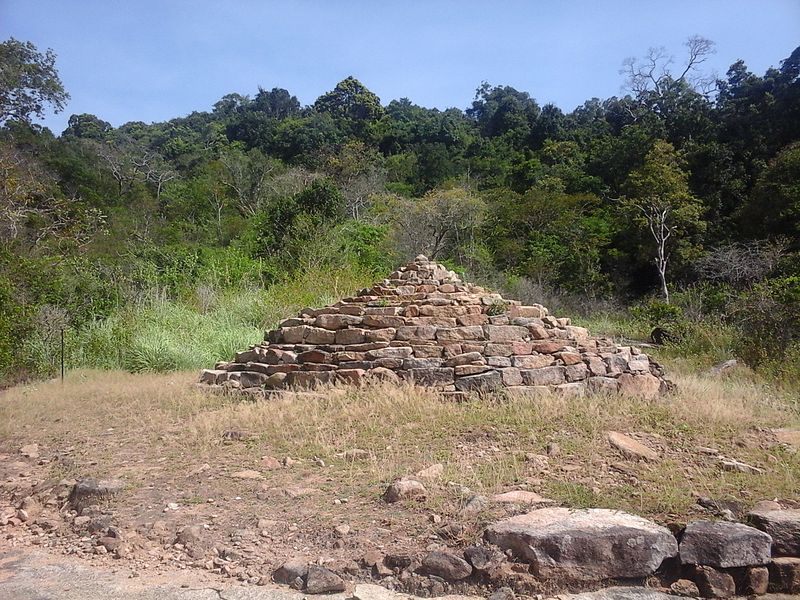OB03178 Timbirivava Inscribed Rock
IN03223 Timbirivava Rock Inscription 1
This inscription is engraved on a rock to the north of the ruined stupa at an ancient site in the forest about three miles south of Maradanmaḍuva, lying about half a mile off the route to Ikirigallǟva. Two other inscriptions are engraved on the same rock (IN03224 and IN03225). The extensive ruins at this site were discovered by the Wild Life Department in 1953. At that time, the site had no name but it now referred to as Tim̆biriväva after an abandoned and breached tank in the vicinity. As head of the Wild Life Department, C. W. Nicholas reported the discovery to the Archaeological Department, whose officers were despatched to survey the inscriptions (see Appendix II of the Administration Report for 1954, nos. 41, 42 and 43).
The present inscription registers the gift of seven hundred kahavaṇa coins to the royal monastery of Masala by Budala Aldara, nephew of Vaḷaba Haladara. ‘Masala’ was evidently the ancient name of the monastic established at the site where the epigraph is located. The inscription is dated in the tenth year of a king styled Kasabala Alakapaya, ‘Kasabala’ being the equivalent of the Pali ‘Kassapa’. Senarath Paranavitana identifies this king as Kassapa I, since the second king of that name only reigned for nine years and the inscription’s palaeography suggests that it predates the reign of Kassapa III. Kassapa I ascended to the throne in around 479 A.D. The application of the title ‘Alakapaya’, which is equivalent to the Sanskrit ‘Alakapati’ (Lord of Alakā), to this king is explained by the Cūḷavaṁsa when it says that Kassapa built on the summit of Sīgiri ‘a fine palace worthy to behold, like another Ālakamandā and dwelt there like (the god) Kuvera’.
OB03177 Rajagala Inscribed Rock commemorating Saint Mahinda
IN03222 Rajagala Inscription of circa 200 B.C. commemorating Saint Mahinda
This inscription is engraved on a rock, which stands among the remains of an extensive ancient monastery on the rocky hill called Rājagala or Rāssahela in the Vävugam Patty of the Batticaloa District. It was discovered in 1935 by W. E. Fernando, the Draughtsman of the Archaeological Department, who had been sent by Senarath Paranavitana to explore the site (see Archaeological Survey of Ceylon Annual Report for 1935, p. 9). Fernando prepared an estampage of the inscription but it did not give a clear reading of the latter part of the inscription, which was faint and covered with moss. A clearer estampage was created sometime later, after the site had been opened up for cultivation and cleared of jungle. The inscription is written in early Brāhmī characters and refers to the two theras called Iḍika (P. Iṭṭhiya) and Mahida (P. Mahinda) in connection with a nearby stupa. Since these two theras are described as having come to the island of Sri Lanka from overseas, the Mahida in question can be identified as Saint Mahinda, who travelled from India to preach Buddhism in Sri Lanka in the third century B.C. It is stated in the chronicle that, after Mahinda’s cremation, half of his bodily relics were distributed across the island, to be enshrined in stupas specially built for the purpose. It would seem that one such stupa was erected at Rājagala and the present inscription was engraved to commemorate this fact. In terms of dating, it is not impossible that the stupa was built shortly after Mahinda’s death, which occurred about 200 B.C., with the inscription being incised around the same time. The palaeography contains nothing that militates against this view.
IN03221 Am̆bagasväva Rock Inscription 2
This inscription is engraved on a rock called Maḍuvegala in the village of Aṁbagasväva in the Divigandahe Kōrale of the Hiriyāḷa Hatpattu, Kuruṇǟgala District. It is written in the Sinhalese script of about the sixth century and records that a named individual settled his debt and caused the cessation of his slavery to the royal monastery of Mayagara. Another, very similar inscription is written on the same rock (IN03220).
OB03176 Am̆bagasväva Inscribed Rock
IN03220 Am̆bagasväva Rock Inscription 1
This inscription is engraved on a rock called Maḍuvegala in the village of Aṁbagasväva in the Divigandahe Kōrale of the Hiriyāḷa Hatpattu, Kuruṇǟgala District. It is written in the Sinhalese script of about the sixth century and records that a named individual settled his debt and caused the cessation of his slavery to the royal monastery of Mayagara. Another, very similar inscription is written on the same rock (IN03221).
OB03175 Galkäṭyāgama Inscribed Rock
IN03219 Galkäṭyāgama Rock Inscriptions
Five inscriptions in the Sinhalese script of about the sixth century are incised on a rock at the site of an ancient monastery at Galkäṭiyāgama, four miles south-west of Polpiṭigama, in the Hiriyāla Hatpattu, Kuruṇǟgala District. Each inscription refers to a named individual and states that he settled his debts and freed himself slavery. The inscriptions have been engraved close to each other, three of them on the left side of the inscribed area and two on the right.
